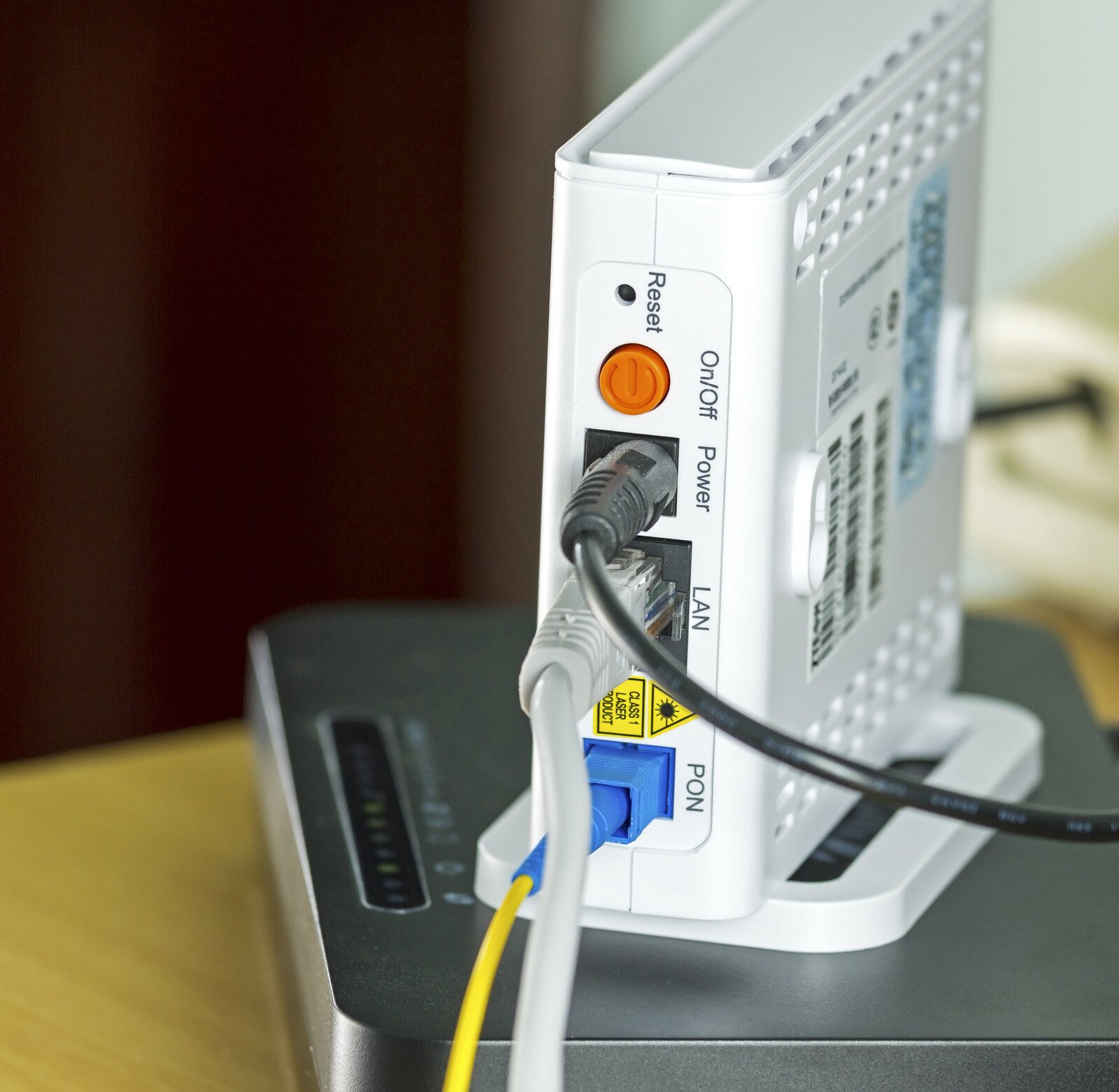Let's face it: a fast, reliable internet connection isn't just nice to have – it's essential. From binge-watching your favorite shows to crushing that work presentation from your home office, modern households rely on the internet to power daily activities. But as our need for more bandwidth keeps growing, so does the need for network tech that can keep up with our insatiable digital appetites.
Enter the passive optical network (PON), a technology that makes it easier and more affordable for internet service providers to deliver high-speed fiber internet to households. Read on to learn everything you need to know about passive optical networks and why they might just be the solution to supercharging your home internet.
What Is a PON (Passive Optical Network)?
A passive optical network is a fiber-optic telecommunications technology designed to provide high-speed internet access to end-users. Unlike active optical networks, which use electrically powered equipment to distribute signals, passive optical networks use unpowered optical splitters to deliver data.
For homeowners, this translates to a more reliable, faster, and potentially cheaper internet connection. PONs can deliver symmetrical speeds (equal upload and download rates) that leave traditional copper-based networks in the dust, and they do it all while using less power and needing less maintenance.

What Does PON Mean on a Router?
When you see “PON” on your router, it stands for Passive Optical Network. This light indicates the status of your fiber connection to the network. A solid green PON light typically means your router is successfully connected to your internet provider’s optical network. If the PON light is off, red, or blinking, it usually signals a disruption—such as a damaged fiber cable, a problem with the optical network terminal (ONT), or a loss of signal from the provider.
Passive Optical Network Architecture: Key Components & Technologies
Now that you know the basics, let's take a look at the components and processes that make passive optical networks work:
Optical Line Terminal (OLT)
The optical line terminal is the starting point of a PON, typically located at your service provider's central office. It acts as the middleman between the internet and your local fiber network. The OLT's job is to convert the electrical signals from the broader network into light signals for transmission over fiber.
The OLT also manages bandwidth allocation, ensuring that each user gets their fair share of the network's capacity. It constantly juggles data requests and prioritizes traffic to ensure everyone's online experience is smooth and snappy.
Optical Network Terminals (ONTs) or Optical Network Units (ONUs)
These devices serve as the endpoint of the fiber network, and they're installed right at your premises. They take those light signals racing through the fiber and translate them back into electrical signals that your laptop, smart TV, or gaming console can understand.
Optical network units also handle important security functions, such as encrypting your data before sending it back up the line. They're your first line of defense against potential eavesdroppers on the network.
Passive Optical Splitters
A passive optical splitter divides the light signal from the OLT into multiple paths, allowing a single fiber to serve multiple customers. They don't need power to operate, so there are fewer points of failure, less power consumption, and lower maintenance costs. For you, that means a more reliable connection and potentially lower bills.
Fiber Optic Cables
Fiber optic cables are super-thin strands of plastic or glass designed to transmit data as pulses of light. But while these cables are the diameter of a human hair, they can transmit massive amounts of data over long distances with very little signal loss. They're also immune to electromagnetic interference, which means no more internet hiccups when your neighbor uses their old microwave.
Time Division Multiplexing (TDM)
Time division multiplexing is like a precisely choreographed dance routine for your internet traffic. In the downstream direction (from the OLT to your house), data is broadcast to all ONUs on the network; however, each ONU only processes the data intended for it. For upstream traffic (from your house back to the OLT), each ONU is assigned specific time slots for data transmission to prevent collisions.
Wavelength Division Multiplexing (WDM)
If TDM is a dance routine, then wavelength division multiplexing is like adding extra dance floors. This technique allows multiple signals to travel over a single fiber optic strand using different colors, or wavelengths, of light.
Picture it like this: red light carries your internet traffic, blue light handles your neighbor's, and green light is reserved for future upgrades. All these colors travel together through the same fiber optic cabling without interfering with each other. It's a clever way to squeeze more bandwidth out of existing infrastructure.
In more advanced PON systems, WDM allows for increased bandwidth and the coexistence of different PON standards on the same physical infrastructure. That means easier upgrades and more flexibility for network operators – and potentially faster speeds for you.

Evolution of PON Technology
Over the years, passive optical networking has been shaped by two main organizations: the International Telecommunications Union (ITU) and the Institute of Electrical and Electronics Engineers (IEEE).
International Telecommunications Union (ITU)
The ITU has been the driving force behind many of the PON standards we use today. Here's how their standards have evolved:
-
APON and BPON: The first PON standard, Asynchronous Transfer Mode PON (APON), emerged in the 1990s. While it wasn't very fast by today's standards, it was revolutionary for its time. APON soon got an upgrade and was rebranded as Broadband PON (BPON), which could deliver speeds up to 622 Mbps downstream and 155 Mbps upstream.
- GPON: The new millennium saw the introduction of Gigabit-capable PON (GPON). This standard offered speeds of 2.5 Gbps downstream and 1.25 Gbps upstream, along with features like better error correction, encryption for improved security, and the ability to transmit multiple services (like internet, TV, and phone) over the same fiber.
- 10G-PON/XG-PON: Introduced in 2010, this standard pushed speeds to a whopping 10 Gbps downstream and 2.5 Gbps upstream. This kind of speed meant you could download entire seasons of your favorite show in the time it takes to make popcorn.
- NG-PON2: In 2015, Next-Generation PON 2 introduced time wavelength division multiplexing (TWDM), allowing for multiple wavelengths per fiber. This standard can deliver symmetrical speeds of 10 Gbps, so you get the same fast pace for both downloads and uploads.
- XGS-PON: The latest and greatest from the ITU, XGS-PON offers symmetrical 10 Gbps speeds and is gaining traction for both home and business use. It's ideal for when you need to upload large work files just as fast as you download them.
Institute of Electrical and Electronics Engineers (IEEE)
The IEEE has also developed its own set of PON standards that focus on Ethernet-based systems. These include:
- EPON: The IEEE introduced Ethernet PON in 2004, offering 1 Gbps symmetrical speeds using familiar Ethernet protocols. It was like bringing the reliability and ease of your office network to the broader internet.
- 10G-EPON: As the name suggests, this standard offers either 10 Gbps symmetrical speeds or 10 Gbps downstream/1 Gbps upstream, depending on the setup. 10G-EPON has been particularly popular in Asia, powering some of the fastest home internet connections in the world.
Types of Passive Optical Networks: Which Fiber PON Is Right for You?
The various PON standards developed by ITU and IEEE have led to several types of passive optical networks, each with its own strengths. The right choice will depend on your need for speed, budget, and what's available in your area, but popular options include:

GPON (Gigabit Passive Optical Network)
GPON is reliable and widely available, and it gets the job done for most households. It offers speeds up to 2.5 Gbps downstream and 1.25 Gbps upstream. While it might not be the newest kid on the block, GPON is still the most widely deployed PON architecture, especially for residential fiber-to-the-home (FTTH) setups.
Why is it so popular? GPON strikes a great balance between performance and cost. It's fast enough for most home users with multiple devices but not so cutting-edge that it breaks the bank for internet service providers to deploy.
XG-PON (10-Gigabit Passive Optical Network)
XG-PON kicks things up a notch with 10 Gbps downstream speeds while maintaining 2.5 Gbps upstream. This asymmetrical setup is great for households that do a lot of downloading or streaming but don't need super-fast upload speeds.
These networks are also backward compatible with GPON, so internet service providers can gradually upgrade their networks without having to rip and replace everything at once. This can mean faster speeds becoming available without any disruption to your service.
XGS-PON (10-Gigabit Symmetrical Passive Optical Network)
XGS-PON offers symmetrical 10 Gbps speeds – that's lightning-fast for both downloads and uploads. This type of passive optical network is gaining traction for both residential and business apps where high upload speeds are crucial. With XGS-PON, you could upload a 4K video to YouTube in seconds, back up your entire photo library to the cloud in no time, or join multiple video conferences without skipping a beat.
NG-PON2 (Next-Generation Passive Optical Network 2)
NG-PON2 shows us what's possible when we push technology to its limits. This advanced standard uses multiple wavelengths of light to achieve speeds up to 40 Gbps downstream and 10 Gbps upstream.
NG-PON2 is finding its niche in enterprise applications and mobile network backhaul. It's also future-proofing networks for the coming waves of high-bandwidth applications like virtual reality and 8K streaming.
EPON (Ethernet Passive Optical Network)
EPON takes a different approach, basing its technology on the familiar Ethernet protocols we've been using in local networks for years. It offers 1 Gbps symmetrical speeds and compatibility with existing Ethernet-based equipment and software. This can make it easier and cheaper for some providers to implement, potentially leading to cost savings for consumers.
10G-EPON (10-Gigabit Ethernet Passive Optical Network)
10G-EPON is the beefed-up version of EPON. It pushes speeds to 10 Gbps symmetrical or 10/1 Gbps asymmetrical. The symmetrical option is great for power users who require high-speed data transmission in both directions, while the asymmetrical option balances fast download speeds with more modest upload capabilities. Like its ITU counterparts, 10G-EPON is designed to meet the growing bandwidth demands of modern households.

PON vs AON: What’s the Difference?
When it comes to delivering fiber internet, service providers typically choose between Passive Optical Networks (PON) and Active Optical Networks (AON). The key difference lies in how data is distributed. PON systems use unpowered splitters to share a single optical signal with multiple users, making them energy-efficient and cost-effective. In contrast, AON systems rely on electrically powered equipment—such as switches or routers—to actively direct data to each user, which allows for dedicated bandwidth but requires more infrastructure and power. While AON can offer slightly better performance for individual users, PON is far more scalable, easier to maintain, and ideal for widespread residential deployments like fiber-to-the-home (FTTH).
Benefits of PON Networks: Why Passive Optical Networks Stand Out
Passive optical networks offer several advantages for your home, including:
Fiber for Everyone
PONs are great at providing fiber internet service to homes with different connectivity needs. Whether you're just checking email or streaming 4K videos all day, PONs can dish out just the right amount of bandwidth.
Easy Upgrades
PONs can use different light wavelengths on the same fiber, enabling providers to upgrade to faster speeds without digging up streets to lay new cables. As a result, network improvements can be implemented more quickly and with less inconvenience to customers.
Cost-Effective to Deploy
PONs can often use fiber already in the ground, which makes it faster and cheaper to bring high-speed internet to more areas compared to other options. The ability to leverage existing resources significantly reduces the overall cost and time required for network deployment.
Future-Proof Infrastructure
The internet keeps evolving, and PONs are built to keep up. They offer many ways to upgrade, so your connection can get faster as technology improves.
Higher Security
PONs are highly secure. They leverage security methods like encryption to make it difficult for anyone to eavesdrop on your data as it travels across the network.
Energy-Efficient
PON networks are inherently energy-efficient, which is good for the environment and operational costs. Their design requires less power consumption than alternative network technologies.
Real-World PON Examples
Fiber to the Home (FTTH)
One of the most common applications of Passive Optical Networks (PON) is FTTH, where a single optical fiber serves multiple homes. This setup provides blazing-fast internet that supports 4K streaming, cloud backups, video conferencing, and smart home devices with ease.
Business and Campus Networks
PON technology is widely used in commercial buildings, corporate campuses, and universities. Instead of running individual fiber lines to each location, a single PON system can connect multiple departments or buildings efficiently—lowering both costs and maintenance.
Hospitality, Healthcare, and Public Spaces
Hotels, hospitals, and transportation hubs use PON to streamline their internal networks. With fewer active components and centralized management, they can support guest Wi-Fi, staff communication, and security systems using one fiber backbone.
Global Telecom Deployments
Major internet providers across the globe deploy GPON, XGS-PON, and EPON to serve urban, suburban, and rural communities. From U.S. suburbs to high-density cities in Asia, PON is a trusted, scalable solution that meets increasing bandwidth demands.
Ready for PON? Get Started With FTTH From Fatbeam
These days, you need internet that can handle everything from your latest streaming obsession to your important work video calls. From blazing-fast speeds and rock-solid reliability to energy efficiency and future-proof scalability, passive optical networks deliver several benefits that make them the perfect choice for modern households.
Fatbeam Fiber’s FTTH solutions use advanced PON networks to bring you internet speeds that'll make your old connection look like dial-up. We offer fiber optic bandwidth from 250 Mbps up to 2 gigabits and fast, local tech support – so you can always count on your internet to deliver the connectivity you need.
We've already got over 2,200 happy customers across eight states and more than 150 cities, and we're not stopping there. We're on a mission to bring fiber internet to areas that have been overlooked by other providers, so why stick with slow, unreliable internet when you can join the Fatbeam family? Reach out today to see why our customers love us.


